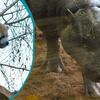Jack Gradidge, Conservation Officer at Folly Farm, writes about the Park’s initiative to conserve native bird species…
At the start of each summer, aerial acrobats join the performance of UK wildlife. Their arrow-shaped bodies make them perfectly adapted to effortlessly glide through the air, twisting and turning in every direction, targeting their next meal.
The happy chattering of swallows and house martins signifies springtime. Later, screams of swifts’ echo through our towns and cities. Fast, slick and gone in a flash, the swifts have arrived, and summer has begun.
These three birds have evolved with humans for thousands of years. Swifts have existed in virtually the same form for around 50 million years. In the 17th century, when vast forests were felled, they began to use the cavities in buildings, an alternative to the tree cavities they’d naturally nest in.
Although not related to swifts, barn swallows and house martins look similar through convergent evolution, a direct result of evolving to a similar ecological niche. Instead of nesting in cavities, these two birds build nest cups made from mud, feathers, dried vegetation and saliva.
All three birds have had to adapt their nesting behaviours to our way of life, and they’ve made use of the cavities and soffits around our homes. After centuries of coexisting, modern development and building practices are frequently inconducive to their nesting needs, with some birds even being evicted after centuries of birds nesting in the same buildings.
Consequently, the BTO defines both house martins and swifts as 'Red Listed', experiencing a decline of 37% and 60% respectively (1995 - 2020). Although swallows are 'Green Listed', they have declined by 23% (1995 - 2020).
At Folly Farm we wanted to help address this decline, so the Hafod yr Adar project was conceived. Hafod yr Adar, or the ‘Birds Summer Dwelling’, consists of a 6.2m high multi-species nesting tower. The structure has 16 swift boxes, each with its’ own entrance hole cut to the specific size for the target species, whilst being too small for starlings. Each box has a concave nest area to prevent egg damage and lined with goose feathers.
The structure has 12 house martin cups, with additional space for natural mud cups to be constructed next to them. Ledges in the roof space accommodates 7 barn swallow nest cups, as well as space for native bats. Made from cornstarch and sawdust, the nest cups are 3D printed and fully biodegradable.
All three species have been observed in the surrounding area, so a specialist bird call system has also been fitted to attract them. The success of new nest sites is most successful with a call system, so it was imperative we included this in the structure.
The tower was kindly funded through the Pembrokeshire Coast Charitable Trust through their ‘Force for Nature Grant’ scheme. A fund to help biodiversity projects in and around the Pembrokeshire Coast National Park.
It can take many years to attract swifts to new nest sites, but staff at Folly Farm are closely monitoring the tower for signs of activity. The tower and associated signage aim to put a spotlight on the decline of the three bird species and spark interest in local communities. The tower has already created enthusiasm in the local area, and Folly Farm are advising a Ceredigion community group, keen to replicate the idea.
- Jack Gradidge, Conservation Officer at Folly Farm
All blogs reflect the views of their author and are not necessarily a reflection of BIAZA's positions
Related Members
-
News
 Belfast Zoo helps to bring Christmas joy to Children’s Hospital 19th December, 2025Belfast Zoo joined the Lord Mayor of Belfast, Councillor Tracy Kelly, on Monday (15th December) to help bring festive cheer to the Royal Belfast Hospital…
Belfast Zoo helps to bring Christmas joy to Children’s Hospital 19th December, 2025Belfast Zoo joined the Lord Mayor of Belfast, Councillor Tracy Kelly, on Monday (15th December) to help bring festive cheer to the Royal Belfast Hospital… -
News
 Colchester Zoological Society welcomes new arrivals 19th December, 2025This December, Colchester Zoological Society (CZS) welcomed some exciting new arrivals! A young male pygmy hippo, Mikolas, from Zoo Dvur Kralove…
Colchester Zoological Society welcomes new arrivals 19th December, 2025This December, Colchester Zoological Society (CZS) welcomed some exciting new arrivals! A young male pygmy hippo, Mikolas, from Zoo Dvur Kralove… -
News
.png?w=100&h=100&zc=1&f=jpeg&hash=8d175f93cde920c5ba23c8ea7f92e55a) Blog: Understanding the human side of zoos 16th December, 2025Why are zoo researchers increasingly looking to social science? Dr Nieky van Veggel explains the significance of understanding the human dimension…
Blog: Understanding the human side of zoos 16th December, 2025Why are zoo researchers increasingly looking to social science? Dr Nieky van Veggel explains the significance of understanding the human dimension…



